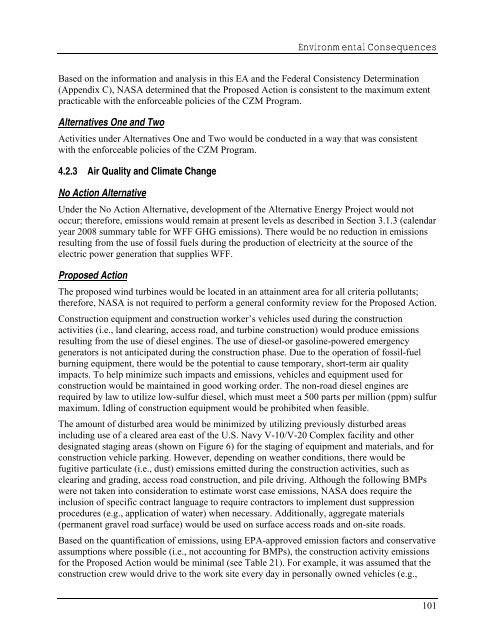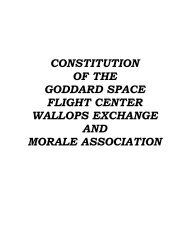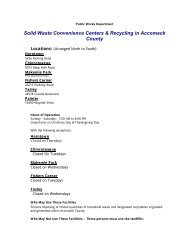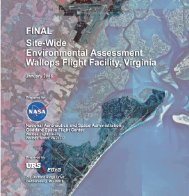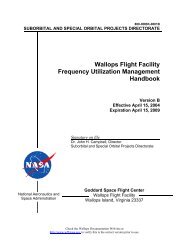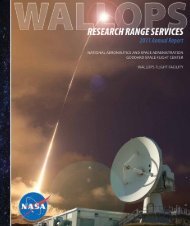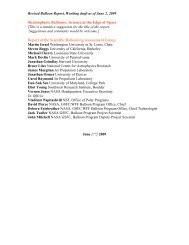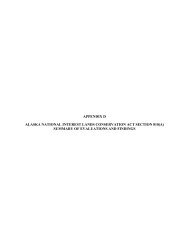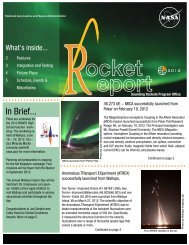Alternative Energy Draft EA - NASA Visitor Center at Wallops Flight ...
Alternative Energy Draft EA - NASA Visitor Center at Wallops Flight ...
Alternative Energy Draft EA - NASA Visitor Center at Wallops Flight ...
You also want an ePaper? Increase the reach of your titles
YUMPU automatically turns print PDFs into web optimized ePapers that Google loves.
Environmental Consequences<br />
Based on the inform<strong>at</strong>ion and analysis in this <strong>EA</strong> and the Federal Consistency Determin<strong>at</strong>ion<br />
(Appendix C), <strong>NASA</strong> determined th<strong>at</strong> the Proposed Action is consistent to the maximum extent<br />
practicable with the enforceable policies of the CZM Program.<br />
<strong>Altern<strong>at</strong>ive</strong>s One and Two<br />
Activities under <strong>Altern<strong>at</strong>ive</strong>s One and Two would be conducted in a way th<strong>at</strong> was consistent<br />
with the enforceable policies of the CZM Program.<br />
4.2.3 Air Quality and Clim<strong>at</strong>e Change<br />
No Action <strong>Altern<strong>at</strong>ive</strong><br />
Under the No Action <strong>Altern<strong>at</strong>ive</strong>, development of the <strong>Altern<strong>at</strong>ive</strong> <strong>Energy</strong> Project would not<br />
occur; therefore, emissions would remain <strong>at</strong> present levels as described in Section 3.1.3 (calendar<br />
year 2008 summary table for WFF GHG emissions). There would be no reduction in emissions<br />
resulting from the use of fossil fuels during the production of electricity <strong>at</strong> the source of the<br />
electric power gener<strong>at</strong>ion th<strong>at</strong> supplies WFF.<br />
Proposed Action<br />
The proposed wind turbines would be loc<strong>at</strong>ed in an <strong>at</strong>tainment area for all criteria pollutants;<br />
therefore, <strong>NASA</strong> is not required to perform a general conformity review for the Proposed Action.<br />
Construction equipment and construction worker’s vehicles used during the construction<br />
activities (i.e., land clearing, access road, and turbine construction) would produce emissions<br />
resulting from the use of diesel engines. The use of diesel-or gasoline-powered emergency<br />
gener<strong>at</strong>ors is not anticip<strong>at</strong>ed during the construction phase. Due to the oper<strong>at</strong>ion of fossil-fuel<br />
burning equipment, there would be the potential to cause temporary, short-term air quality<br />
impacts. To help minimize such impacts and emissions, vehicles and equipment used for<br />
construction would be maintained in good working order. The non-road diesel engines are<br />
required by law to utilize low-sulfur diesel, which must meet a 500 parts per million (ppm) sulfur<br />
maximum. Idling of construction equipment would be prohibited when feasible.<br />
The amount of disturbed area would be minimized by utilizing previously disturbed areas<br />
including use of a cleared area east of the U.S. Navy V-10/V-20 Complex facility and other<br />
design<strong>at</strong>ed staging areas (shown on Figure 6) for the staging of equipment and m<strong>at</strong>erials, and for<br />
construction vehicle parking. However, depending on we<strong>at</strong>her conditions, there would be<br />
fugitive particul<strong>at</strong>e (i.e., dust) emissions emitted during the construction activities, such as<br />
clearing and grading, access road construction, and pile driving. Although the following BMPs<br />
were not taken into consider<strong>at</strong>ion to estim<strong>at</strong>e worst case emissions, <strong>NASA</strong> does require the<br />
inclusion of specific contract language to require contractors to implement dust suppression<br />
procedures (e.g., applic<strong>at</strong>ion of w<strong>at</strong>er) when necessary. Additionally, aggreg<strong>at</strong>e m<strong>at</strong>erials<br />
(permanent gravel road surface) would be used on surface access roads and on-site roads.<br />
Based on the quantific<strong>at</strong>ion of emissions, using EPA-approved emission factors and conserv<strong>at</strong>ive<br />
assumptions where possible (i.e., not accounting for BMPs), the construction activity emissions<br />
for the Proposed Action would be minimal (see Table 21). For example, it was assumed th<strong>at</strong> the<br />
construction crew would drive to the work site every day in personally owned vehicles (e.g.,<br />
101


